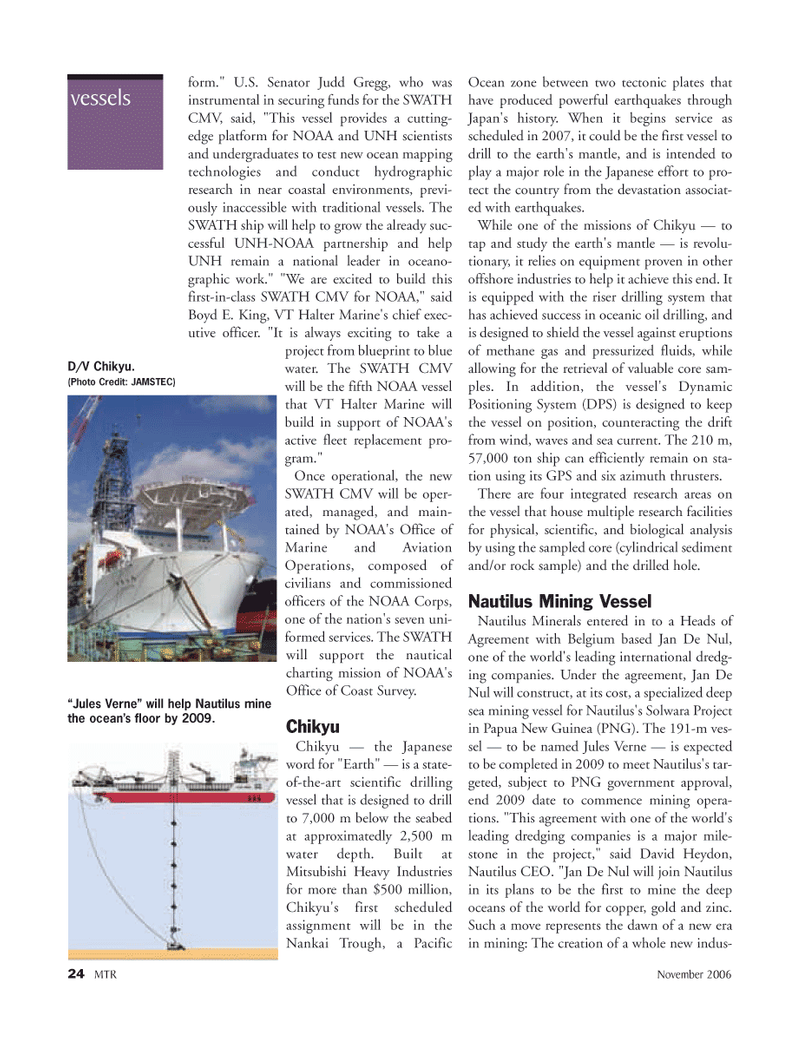
Page 24: of Marine Technology Magazine (November 2006)
Deep Ocean Exploration
Read this page in Pdf, Flash or Html5 edition of November 2006 Marine Technology Magazine
24 MTR November 2006 form." U.S. Senator Judd Gregg, who was instrumental in securing funds for the SWATH
CMV, said, "This vessel provides a cutting- edge platform for NOAA and UNH scientists and undergraduates to test new ocean mapping technologies and conduct hydrographic research in near coastal environments, previ- ously inaccessible with traditional vessels. The
SWATH ship will help to grow the already suc- cessful UNH-NOAA partnership and help
UNH remain a national leader in oceano- graphic work." "We are excited to build this first-in-class SWATH CMV for NOAA," said
Boyd E. King, VT Halter Marine's chief exec- utive officer. "It is always exciting to take a project from blueprint to blue water. The SWATH CMV will be the fifth NOAA vessel that VT Halter Marine will build in support of NOAA's active fleet replacement pro- gram."
Once operational, the new
SWATH CMV will be oper- ated, managed, and main- tained by NOAA's Office of
Marine and Aviation
Operations, composed of civilians and commissioned officers of the NOAA Corps, one of the nation's seven uni- formed services. The SWATH will support the nautical charting mission of NOAA's
Office of Coast Survey.
Chikyu
Chikyu — the Japanese word for "Earth" — is a state- of-the-art scientific drilling vessel that is designed to drill to 7,000 m below the seabed at approximatedly 2,500 m water depth. Built at
Mitsubishi Heavy Industries for more than $500 million,
Chikyu's first scheduled assignment will be in the
Nankai Trough, a Pacific
Ocean zone between two tectonic plates that have produced powerful earthquakes through
Japan's history. When it begins service as scheduled in 2007, it could be the first vessel to drill to the earth's mantle, and is intended to play a major role in the Japanese effort to pro- tect the country from the devastation associat- ed with earthquakes.
While one of the missions of Chikyu — to tap and study the earth's mantle — is revolu- tionary, it relies on equipment proven in other offshore industries to help it achieve this end. It is equipped with the riser drilling system that has achieved success in oceanic oil drilling, and is designed to shield the vessel against eruptions of methane gas and pressurized fluids, while allowing for the retrieval of valuable core sam- ples. In addition, the vessel's Dynamic
Positioning System (DPS) is designed to keep the vessel on position, counteracting the drift from wind, waves and sea current. The 210 m, 57,000 ton ship can efficiently remain on sta- tion using its GPS and six azimuth thrusters.
There are four integrated research areas on the vessel that house multiple research facilities for physical, scientific, and biological analysis by using the sampled core (cylindrical sediment and/or rock sample) and the drilled hole.
Nautilus Mining Vessel
Nautilus Minerals entered in to a Heads of
Agreement with Belgium based Jan De Nul, one of the world's leading international dredg- ing companies. Under the agreement, Jan De
Nul will construct, at its cost, a specialized deep sea mining vessel for Nautilus's Solwara Project in Papua New Guinea (PNG). The 191-m ves- sel — to be named Jules Verne — is expected to be completed in 2009 to meet Nautilus's tar- geted, subject to PNG government approval, end 2009 date to commence mining opera- tions. "This agreement with one of the world's leading dredging companies is a major mile- stone in the project," said David Heydon,
Nautilus CEO. "Jan De Nul will join Nautilus in its plans to be the first to mine the deep oceans of the world for copper, gold and zinc.
Such a move represents the dawn of a new era in mining: The creation of a whole new indus- vessels “Jules Verne” will help Nautilus mine the ocean’s floor by 2009.
D/V Chikyu. (Photo Credit: JAMSTEC)
MTR#9 (17-32).qxd 11/13/2006 4:47 PM Page 24

 23
23

 25
25
